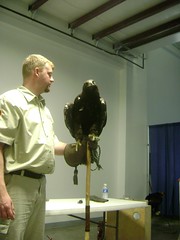Raptor Notes
Raptor Identification by Ben Woodruff, SkyMasters
"This program is geared towards serious bird watching enthusiasts. Ben will share many non-traditional and little known identification tips. Live raptors will be displayed in this program as well as digitally displayed images."
--------------------------------------------------------
When identifying raptors take the time to ask yourself these questions:
What is the bird doing?
Where is the bird?
These can help you figure out what the bird might be.
--------------------------------------------------------
Falcons are like bricks the weight of 5 large raptors are compressed into this little raptor making them super dense and heavy. The exception is the Kestrel.
Falcons DO NOT glide. They zoom to their destination without a pause in the wing beat or a dip in the flight plan. Unstoppable cruising speed that they use to catch other birds for dinner
Falcons have long skinny wings.
Kestrel v Merlin
When sitting they have different silhouettes. The Kestrel nips in at the rump and then out for the tail. The Merlin does not.
Peregrines have stumpy tails
Prairie falcons are less tolerant of humans. They LOVE larks and are found in the prairie hunting them. Particularly abundant on the salt flats desert.
The Gyrfalcon has a longer wing and can be found in the Bear River area in Feb & March
Prairie falcons are darker underneath. They like to sit on the second rung down on the telephone poles (to help hide from larger raptors). They will lean next to the post or "hug" the post in order to hide.
If it is a falcon in the city it is a peregrine.
When hunting other birds the peregrine will strike, circle up and strike again.
When hunting other birds the Prairie falcon will hit just as it is coming up under its circle.
--------------------------------------------------------
Hawks or Buteos have long broad wings. They are the "soaring hawks"
Buteos don't worry about eagles eating them so there is no hiding near fence posts.
They have very broad shoulders and glide, there is an up and down motion in flight. In Utah Swainson's are the summer hawk, Red Tails and Ferriginous (the prairie eagle) the spring and fall, and Rough legged in the winter.
Ferriginous hawks have tiny feet and hunt on the ground.
Harris hawks are pack birds
--------------------------------------------------------
Accipters are forest hawks. They are high strung and aggressive.
Goshawks are not found in town
Coopers & Sharp shinned can be spotted in neighborhood trees.
Coopers have a white tip on their tail that is noticeable.
Sharp-shinned do have a white tip, but it is not noticeable.
Accipters have shorter wings compared to their height, and they love water.
Accipters have big deep rowing wing beats (pigeon like). They will flap 3-4 times then soar. Look for them in canyons hunting for ground squirrels.
Goshawks nest in areas with Fir and Aspen. their nests of sticks are right next to the trunk of the tree.
--------------------------------------------------------
A Harrier is hawk size but really light, it hunts by coursing out over fields.
--------------------------------------------------------
Great horned, burrowing, barn and short-eared owls can be spotted in the daytime.
--------------------------------------------------------
Golden eagles are aggressive, they pull their heads in close to their body to take off and have a longish tail.
Bald eagles are more social and tend to have "poofy" heads. They keep their heads down to take off and have a shorter tail.
This was a fascinating lecture and one I will remember for always. If you have a chance to attend one of their lectures, GO!
--------------------------------------------------------

No comments:
Post a Comment